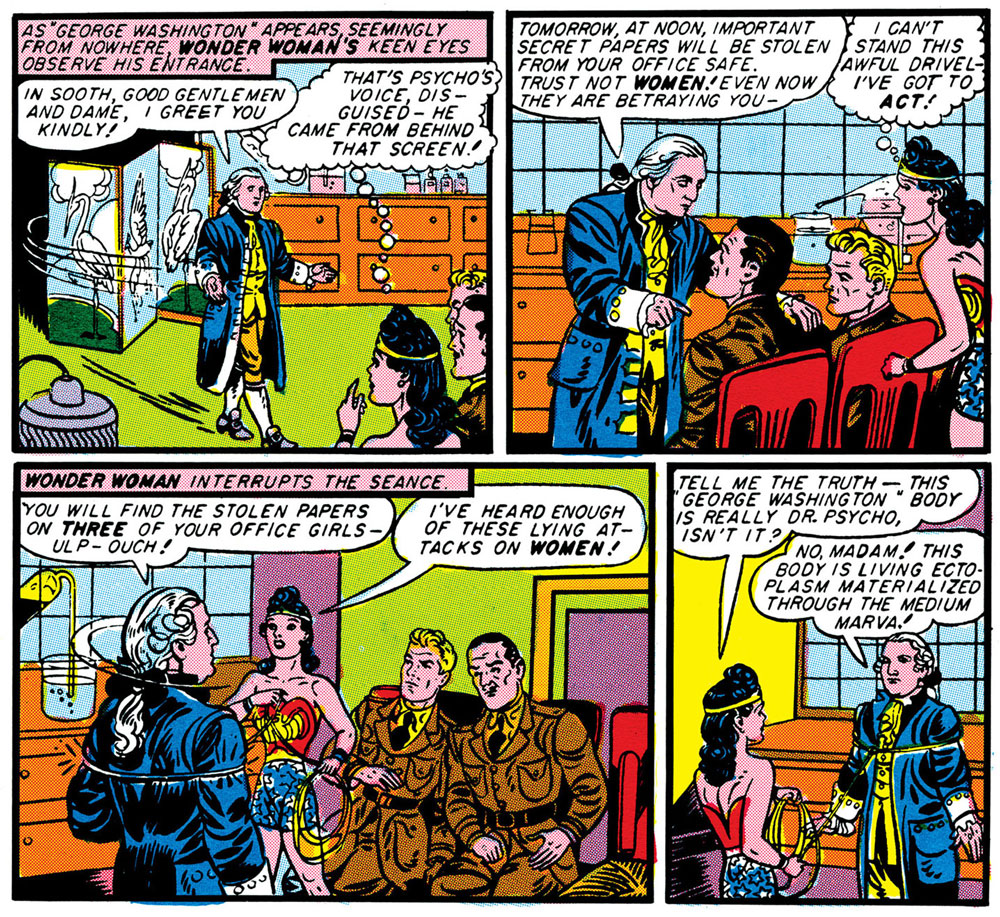The Golden Lasso
Wonder Woman and the birth of the lie detector
Ken Alder

Wonder Woman was born fully armed, like Athena, out of the head of a man. But even though William Moulton Marston gave birth to Wonder Woman in an instant—on a dare, really—he armed her with attributes drawn from his lifelong experience.
Throughout his hopscotch career—as a dissident psychologist, frustrated lawyer, movie-tester, advertiser, novelist, advice columnist, and comic book author—Marston toyed with America’s penchant for self-deception. The nation, in his diagnosis, suffered less from cognitive dissonance than from an emotional disconnect. But in 1941, with the nation about to engage a power-mad foe, Americans would have to submit to proper emotional guidance if they wished to remain free. Marston created Wonder Woman, with her golden lasso and sexual allure, to compel our loving submission.
Twenty years earlier, while still a Harvard undergrad, Marston had hit on the novel idea of ascertaining a subject’s honesty by measuring his or her blood pressure, on the theory—suggested by his wife-to-be—that the accompanying emotional duress would be revealed by the heart. It was the first lie detector, and became Marston’s all-purpose gauge of emotional truthfulness.
Marston and his wife were collaborating on his doctoral research when they made the further discovery that subjects responded differently to his questions than to hers. He followed up on this insight at Tufts University, where, with the aid of a student named Olive Byrne, he tested sorority sisters during a hazing ritual in which sophomores compelled first-years to dress in baby clothes and obey frivolous commands. The ritual, he noted, gave intense pleasure to both master and slave, despite assertions to the contrary. Marston’s conclusion: most people wish to submit to a superior power, and women are the superior sex because they willingly submit to love. He publicly predicted that within a hundred years “the country will see the beginning of a sort of Amazonian matriarchy.” And he preached this message in every conceivable medium—while seeking to make the media themselves more emotionally authentic.
Marston worked for Universal Studios, monitoring the audience’s physiological responses to films, which were then edited to calibrate their emotional pitch. He labored on Madison Avenue, testing ads and vouching for products. He preached emotional honesty in women’s magazines and in his clinical practice, where he used his lie detector to free men and women from “twists, repression and emotional conflicts.” By then, Olive Byrne had joined Marston and his wife in a ménage à trois. It was by all accounts a harmonious arrangement, with each woman bearing two of Marston’s children.
Then, in 1939, Charles Gaines, the publisher of such titles as Superman, co-opted Marston (a sometime critic of the comics) onto his board at All-American Publications. Once inside, Marston boasted that he could create the first female superhero. The editors were dismissive, but Gaines gave him a year. In February 1941, he delivered the first script for “Suprema, the Wonder Woman.”
Marston called her golden lasso, which draws out the truth, a symbol of “woman’s love charm and allure with which she compels men and women to do her bidding.” The Amazonian bracelets symbolize her submission to the Goddess Aphrodite: she can use them to deflect bullets, but loses her strength if a man attaches chains to them. (Apparently Olive Byrne favored bracelets of this sort.) In early issues, Marston set Wonder Woman’s cheeky sexiness against the sexual power-worship of Nazis and Japanese militarists. He also highlighted America’s relatively positive attitudes toward women, without neglecting their struggle for equality at home.
In the panel opposite, Wonder Woman battles the fiendish Doctor Psycho, a stunted, misogynistic psychologist who has become a showman-prestidigitator in the mold of Thomas Mann’s “Mario the Magician,” deploying America’s most trusted icons to convince the nation that women are undermining the war effort.
The plot warns us to mistrust appearances, and that freedom lies in the submission to benign authority. Psycho, using his hypnotic powers, has compelled his former fiancée Marva to marry him. He then enslaves her as his psychic medium, enabling him to assume any bodily form he desires. Initially, he becomes Mussolini, but soon conjures up George Washington himself. By tricking the female workers at the munitions factory into hiding secret documents in their undergarments, Psycho wins the trust of Wonder Woman’s boyfriend Steve, whom he then ensnares and impersonates in order to lure Wonder Woman into his trap. She too is bound, and it is only thanks to the intervention of her sorority sidekicks that she is able to liberate herself, her boyfriend, and Marva, whom she frees by interrogating her on a lie detector and then with her golden lasso. The episode ends with the sorority sisters chasing Psycho with a giant paddle. “Catch him kids, give him the Lambda Beta treatment!” Now there’s an all-American cure for liars and self-deceivers alike.
Ken Alder teaches history at Northwestern University. His most recent book is The Lie Detectors: The History of an American Obsession (Free Press, 2007).